Science Without Borders® is a registered trademark of the Khaled bin Sultan Living Oceans Foundation.
When Walter Wyatt’s airplane went down in remote seas in the Western Bahamas, it sank almost immediately.
The unfortunate pilot could not have imagined that a quarter-century later, his sunken plane would play an important part in a discovery that may help scientists better understand coral reef ecosystems.
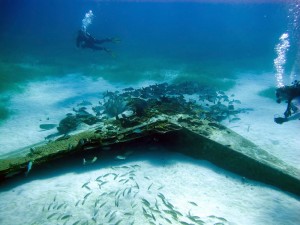
In April, 2011, researchers from the Global Reef Expedition, a Science Without Borders® project of the Khaled bin Sultan Living Oceans Foundation, found Walter’s submerged twin-engine plane. That discovery shed light on the mysterious formation of perfectly circular “meadows” of seagrass halos.
On December 4, 1986, Walter Wyatt left Nassau and was heading to Florida. He knew he was taking a risk; his plane had been vandalized and most of the instruments had been stolen. But the weather forecast was good, and he had a hand-held radio and a compass.
As he flew towards Florida, he began encountering thunderstorms. Then he discovered his compass had been damaged. He was lost and flying blind. He radioed for help… and then his engines failed.
He managed to bring the plane down onto the ocean surface, suffering only minor injuries in the process. He grabbed a life jacket and several flares, and then stepped out onto the wing. Minutes later the plane sank beneath him.
Walter Wyatt was now alone in the dark waters of Cay Sal Bank.
FROM TRAGEDY TO DISCOVERY
More than 99 percent of Cay Sal Bank lies under shallow water 5-12 meters in depth. Light filters down from the surface making the bank prime habitat for coral reefs. These reefs were first stop on the Living Oceans Foundation’s multi-year Global Reef Expedition. The Foundation is dedicated to studying and preserving coral reefs around the world through Science Without Borders®. A core part of this mission is to create extremely detailed maps of reef systems.
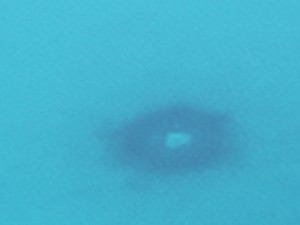
Mapping reefs requires spending many hours underwater. So prior to conducting underwater studies, the coral reef research team scours satellite images of an area to determine where to survey. When they looked at images of Cay Sal Bank they noticed mysterious, perfectly round circles of seagrass on the sea floor. Many of them were solid circles while others contained an inner “doughnut hole,” or seagrass halos, where the grasses appeared to be absent. The circles ranged in diameter from a few dozen meters to hundreds of meters.
Scientists have long known that seagrasses are important to the health of coral reefs, because they provide vital nursery habitat and feeding areas to many animal species that live in and around reefs. So it wasn’t surprising to see underwater meadows of seagrass among the many coral reefs found in this part of the Atlantic, but their round shape was baffling, as were the seagrass halos.
Once at Cay Sal Bank the research team used GPS information to locate the circles. Dr. Sam Purkis of the National Coral Reef Institute leads the ‘ground truthing’ effort, which verifies in situ what the team has previously seen in the satellite images.
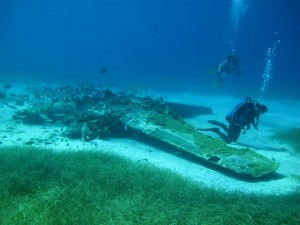
Dr. Purkis was able to inspect the seagrass meadows via both direct observation and remote submersible cameras. He quickly discovered at least part of the reason for the “doughnut holes.”
Dr. Purkis said, “At the center of each doughnut-shaped meadow we found a synthetic object.” These included shipwrecks, abandoned oilrigs and, Walter Wyatt’s downed twin-engine airplane. Moreover, a narrow band of sand called a “halo,” where no seagrasses grow, surrounded each of these objects.
The circles were getting more mysterious. The scientists wanted to understand why the grasses grow in some places but not in others, why they were round, and why manmade objects at the center of the circle created seagrass halos of grass-free sand.
WHAT LIES BENEATH
Cay Sal Bank is typical of many places where coral reefs thrive; its waters are warm, shallow and nutrient-poor. The lack of nutrients prevents seagrasses from growing in many areas.
While surveying Cay Sal Bank, the Khaled bin Sultan Living Oceans Foundation Science Without Borders® researchers came across a number of dramatic “blue holes.” These are sinkholes on the sea floor that can drop off for more than 100 meters. These perfectly circular areas of deep water appear dark blue, in stark contrast to the light green-blue hue of the shallow waters that make up most of Cay Sal Bank.
Among the instruments the scientists used to survey the sea bed of the area was a “sub-bottom profiler,” a type of acoustic imager that looks at the geologic strata beneath the sea floor. These images revealed that there were many sink holes that have been filled in with sandy sediment. It was right on top of these filled in sinkholes that the solid circular seagrass halos were growing.

Now the question was why the seagrasses were able to grow in the sand over the sinkholes and around the man-made objects, but not in other areas of the sandy sea bottom. The scientists speculated that nutrients were the key.
Research by Dr. Craig Layman, of Florida International University, and Jacob Allgeier, of University of Georgia, may provide the answer. They have found elevated levels of phosphorus, one of the nutrients needed by seagrasses, in underwater sinkholes. At Cay Sal Bank, the sea floor consists largely of limestone. Normally, phosphorus binds chemically with limestone, and is thus not available to underwater plants. But in the oxygen-starved environment at the bottom of filled-in sinkholes, phosphorus dissociates from limestone. Both Layman and the Living Oceans Foundation researchers believe that through natural water flow, small amounts of the unbound phosphorus slowly rise through the sediment to the sea floor, where it becomes available to seagrasses.
That explains the circular seagrass meadows over the sinkholes. But the doughnut shaped meadows presented a different problem for the scientists.
MUST BE THE FERTILIZER
What the researchers didn’t understand was how, in these nutrient-poor waters, synthetic objects had also given rise to circular seagrass meadows.
Underwater observations made during reef surveys revealed that Walter Wyatt’s plane is acting as an artificial reef, providing safe harbor for many fishes and marine invertebrates. In the immediate area where large numbers of animals congregate, such as in and around all these artificial reefs, a ready and on-going source of nutrients is available.
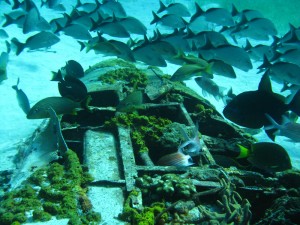
This “fertilizer,” the researchers believe, is the waste excreted by the animals that make the reefs home. To avoid predators, these creatures typically venture just a short distance from the safety of the reefs. As a result, they fertilize a relatively narrow ring around the ‘reef’ or object. It’s in this circular ring where seagrass thrives.
Again, measurements by Dr. Layman and Allgeier support this hypothesis. Their research shows that animal waste in these waters can provide the phosphorus and other nutrients needed by seagrass.
The reason for the seagrass halos around the artificial reefs remains unknown. Some believe they’re due to grazing by the herbivorous animals that congregate around the reefs. But Layman, Allgeier, and the Living Oceans Foundation scientists, believe the halos may arise because the reef animals constantly disturb the sediment immediately adjacent to the man-made reefs. This prevents the grasses from taking root in these narrow bands. In either case, it’s a natural phenomenon caused by the very animals that depend on reefs, be they coral or man-made, for their survival.
The findings of the Global Reef Expedition will help the Bahamian government better manage Cay Sal Bank. That should lead to improved protection of the coral reefs that are such a vital part of ocean environments. That’s good news for coral reefs in the western Atlantic Ocean, and for people everywhere concerned about coral reef research and marine science conservation.
OUT OF TRAGEDY…
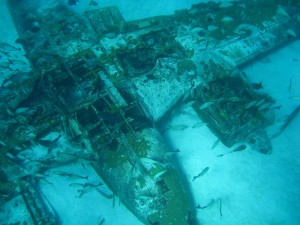
A quarter-century ago, Walter Wyatt’s airplane failed him. Being lost at sea was “the most harrowing experience” of Walter’s life. Yet the accident ultimately helped scientists better understand the coral reef ecosystems that are so vital to healthy ocean environments.
Walter spent a long night alone in the Atlantic Ocean, unable to see more than a meter in any direction. He had to constantly pull biting parasites off his legs. He knew he’d been given up for dead.
When daylight finally came, it was not much of a blessing. His eyes were nearly swollen shut, and his life jacket was failing. He couldn’t see much, but he did spy several sharks hovering in the water around him. Walter was certain he’d be dead in a few hours.
Though not a religious man, he prayed—not to be saved, but for a quick death from hypothermia. He couldn’t bear the thought of being eaten by a shark.
Then, like the researchers who stumbled upon his plane, Walter got lucky. The Coast Guard, searching for the wreckage of his plane, found him instead. It took almost a year-and-a-half, but Walter Wyatt recovered and resumed his career as a commercial airline pilot.
And also like the scientists of the Global Reef Expedition, he now feels that he benefited from his terrible misfortune.
“It was a life-changing experience for me, and not entirely to the negative,” he explained recently. “For one thing, I found out I wasn’t the only being in the world. I found out I was fragile.”
As are coral reefs everywhere.
—————————————————————————
Science Without Borders® is the overarching theme of the Khaled bin Sultan Living Oceans Foundation. Its purposes are to provide financial sponsorship of marine science conservation, coral reef research, coral reef conservation and scientific research expeditions, and to promote public awareness of the need to preserve, protect and restore the world’s oceans and aquatic resources.